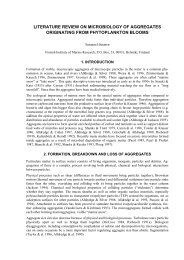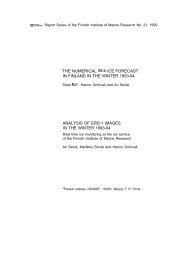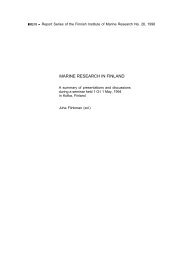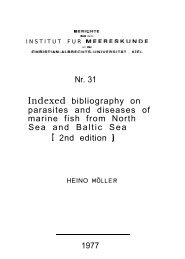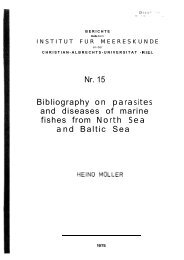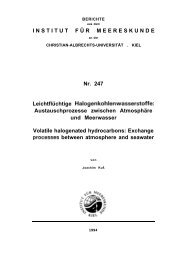BALTIC SEA ENVIRONMENT PROCEEDINGS No. 80
BALTIC SEA ENVIRONMENT PROCEEDINGS No. 80
BALTIC SEA ENVIRONMENT PROCEEDINGS No. 80
- No tags were found...
Create successful ePaper yourself
Turn your PDF publications into a flip-book with our unique Google optimized e-Paper software.
RESULTS AND DISCUSSIONBottom sediments play an important role in aquatic ecosystems, because they usually act as a final sinkfor organic material produced in the water phase, as well as for other particles transported by watercurrents from adjacent sea areas or other water courses and from adjacent terrestrial areas. As they slowlysink, the particles tend to bind foreign substances from the water phase and sweep them to the bottom(e.g. radionuclides and other contaminants).In favourable sedimentation conditions, suspended particles form undisturbed laminae in chronologicalorder, and bottom sediments create an archive from which the historical features of a lake or sea area canbe read. Various particle-bound substances can be used as markers of certain historical events or periods.With the aid of these markers the laminae can be dated. Consequently, the amounts of Chernobylderivedradionuclides, for example, in sediments and their depth distribution in different sediment layersprovide an excellent opportunity to study any errors caused by different sampling equipment ortechniques. The concentration peaks of certain transuranic elements (e.g. Pu-238 and Pu-239,240) causedby weapons test fallout in the 1950s and ’60s also provide useful markers in sedimentological studies.The analysis results for different slices of the sediment cores taken during the MOSSIE exercise aregiven in the Appendix. The vertical profiles of Cs-137 and Cs-134 and the total amounts of Cs-137 inthe entire cores are shown in Figs 6-13. <strong>No</strong>rmally the samples were analysed at the laboratory thattook the samples. However, two cores taken by the Finnish Gemini Twin Corer were analysed by theKhlopin Radium Institute, Russia (stations Teili-1 and XV-1).In connection with the sampling exercise the IAEA-MEL, Monaco, arranged an intercalibrationexercise on radionuclide analyses based on 3 sediment samples taken from the Baltic Sea (IAEA-300,-378, -379). The samples were provided by BSH, Germany (IAEA-300 from the Bothnian Sea andIAEA-378 from the Gotland Deep) and the Polish Institute of Oceanology, Sopot (IAEA-379 from theGulf of Gdansk). The results have been published (Ballestra et al., 1994) and generally showed verygood comparability between the MORS laboratories.Depth profiles of radionuclidesStation BY-15At station BY-15 (237 m) in the Gotland Deep, the type of sediment is very soft and the water content inthe surface layers of the sediment is very high. Thus, there is a significant risk that the surface layers willbe disturbed, mixed or even blown away during sampling. The relatively low concentrations of Cs-137were generally restricted to the uppermost layers of the sediment (Fig. 6).The lowest dry weight values (0.03-0.04 g cm -3 ) in the surface layer (0-2 cm) were sampled with theNiemistö G (=German), Gemini and Niemistö A (=Aranda) corers and the highest (0.21-0.25 g cm -3 )with the Small Box Corer and Large Box Corer. The highest Cs-137 peak (207 Bq kg -1 dry wt.) was alsoobtained with the Niemistö G, but the highest total value in the whole profile (630 Bq m -2 ) was obtainedwith the Aquarius. At this station quite comparable Cs-137 results were obtained with the Niemistö G,Aquarius, Gemini, Sprut and Niemistö A. In some of the cores, relatively high concentrations of Cs-134were detected from below the uppermost 0-2 centimetres (Fig. 7), which might indicate appearance ofthe smearing effect. Plutonium was not analysed at this station.




